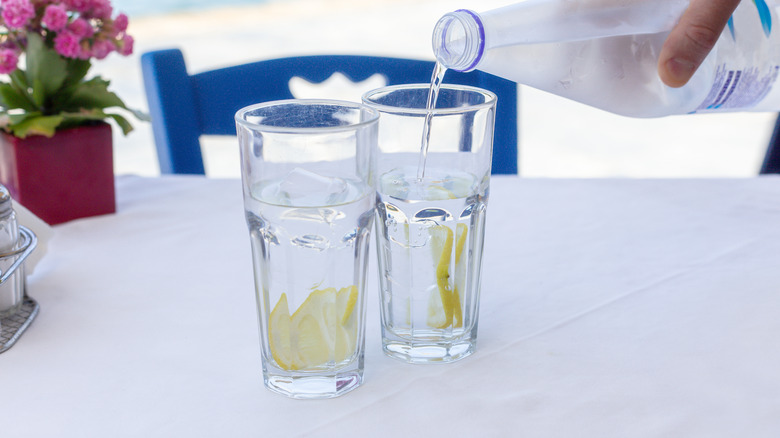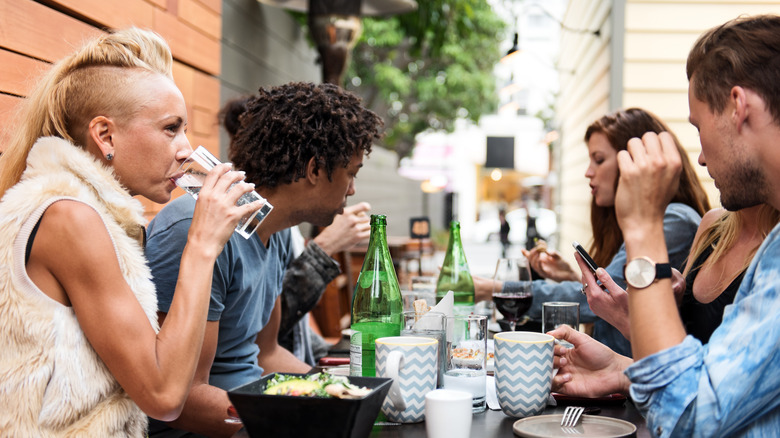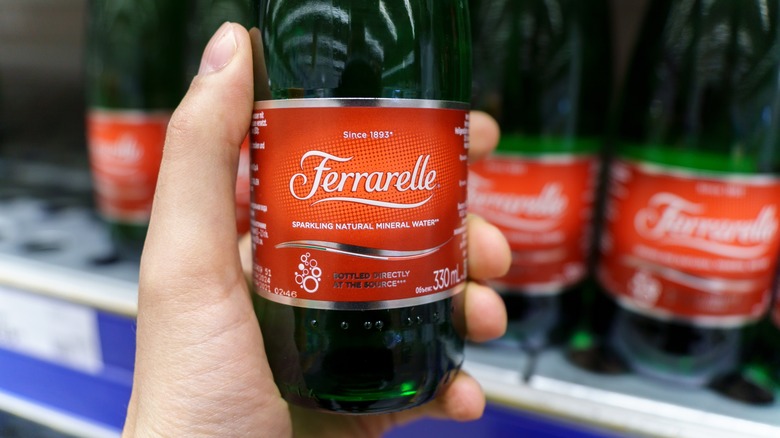The Type Of Water Tourists Should Expect To Drink More Of While On A Trip To Europe
"Sparkling or still?" asks the waiter at the Roman trattoria as you sit down at the table to have your first dinner in Italy. "Still," you say, as you're used to good old-fashioned, non-spicy water (even from the tap), ideally very cold and with ice. The server's question might have caught you off guard, even more so if they asked it in Italian: "Acqua frizzante o natrale?" For many North Americans, still water is the go-to, with sparkling water usually being just a cocktail mixer or only reserved for special occasions.
In contrast, across much of Europe, sparkling water is not just a choice — it's a staple, a default, and even an institution! In many European countries, sparkling water is as common as still water, if not more so. While this effervescent CO2-infused drink is readily available at bars, restaurants, and grocery aisles in the U.S. and Canada, it doesn't enjoy the same level of everyday popularity. In Europe, however, sparkling water is a fixture at the dining table.
The cultural preference for sparking water can be traced back to centuries-old traditions. In countries like Germany and Italy, mineral-rich springs that produce naturally carbonated water are plentiful and have been prized for their health and therapeutic benefits for millennia. Over time, as the technology to artificially carbonate water became widespread, sparkling water became an affordable and health-conscious luxury. It's a natural, low-calorie, and sugar-free beverage that contains no artificial additives — and it's one of the best non-alcoholic drinks that locals swear by.
Regional variations of sparkling water
In Germany, for example, sparkling water is the default and still water is the exception. Germans consume more sparkling water per capita than any other nation! In fact, 78% of all bottled water consumed in Germany is sparkling (per Atlas Obscura), and the town of Selters has given the term "seltzer" to the world. Germans drink around 138 liters (36.5 gallons) of sparkling water per year, while Americans barely drink 5 liters of the fizzy stuff. "Sprudelwasser" or "wasser mit kohlensäure" are essential words you need to know before your trip to Germany.
Italy, another sparkling water stronghold, has a philosophy: Water is not just water. Tap water? No way. Although it's safe to drink, tap water in Italy may not taste great — the water is very hard. That's why bottled, sparkling water is better. In the volcanic south of Italy, you'll find subtle, naturally carbonated water, while the non-volcanic north lacks the springs that produce naturally "frizzante" water, so the gas gets added with strong, industrial-grade bubbliness.
Perrier? That's France. In Paris, you might even stumble upon sparkling water fountains. The French are known for their love of fine dining, and a glass of "le eau gazeuse" is seen as an essential part of the meal, helping to cleanse the palate between courses. In contrast, in the United Kingdom, still water is the norm — the average Brit drinks only 7.5 liters (2 gallons) of bubbly annually (per the Natural Source Waters Association), even though sparkling water is still widely available in the U.K.
Navigating the sparkling water scene in Europe
One of the reasons for the widespread popularity of sparkling water in Europe is its association with health. European mineral waters, many of which are naturally carbonated, are rich in essential minerals such as calcium, magnesium, potassium, sodium, and many others (per Medical News Today). These minerals have various health benefits, like aiding digestion and maintaining electrolyte balance (perfect as a hangover cure, especially if you're going to this gorgeous Greek party island). Sparkling is seen as a more sophisticated and refreshing alternative to still water. For some, the carbonation makes the water feel more substantial, and the slight acidity can enhance the flavors of food. Also, there's just something about an ice-cold bottle of naturally effervescent water on a hot summer vacation.
So ... where to begin with the European seltzer scene? When ordering at a restaurant, you'll be asked whether you prefer sparkling or still water. If you don't specify, you might automatically be served sparkling. In some countries, particularly in Southern and Eastern Europe, tap water is not always offered in restaurants. Bottled water — still or sparkling — is the norm, and it's charged separately. In Italy, try San Pellegrino, Ferrarelle, or Lurisia. When in Germany, try Gerolsteiner, Apollinaris, or Selters. In France, go for Perrier, Badoit, or St-Yorre. Elsewhere in Europe, enjoy Borjomi, Spa, or Borsec. With the wide variety of brands and flavors of sparkling water available, there's a good chance you'll find one that suits your palate.


